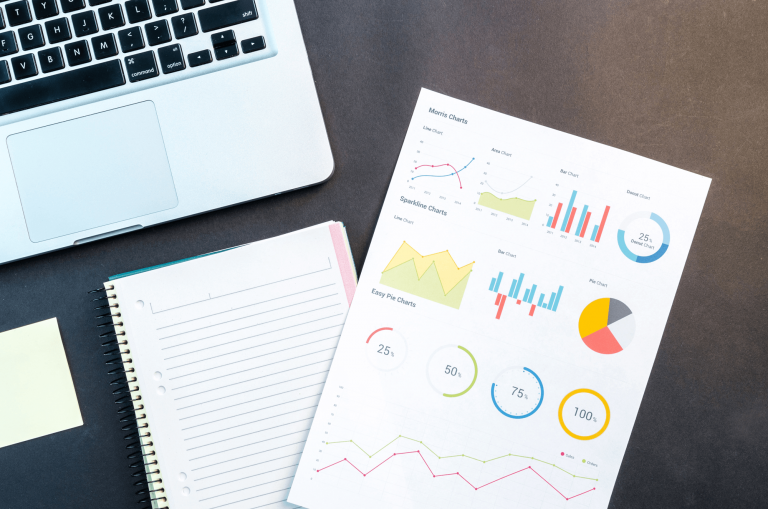Data visualizations make your data readable
The exponential increase in data reflects our ability to measure more, and by extension, gain new valuable insights. Yet the idea of working with data remains inaccessible to many of us. Translating your data from numbers into graphs, reports, or a map can significantly enhance your professional effectiveness and efficiency. Data visualization makes it possible to transform hordes of information into tangible and readable formats, making data more accessible and usable. It is a powerful tool that can elevate your work to the next level. Do you want to know how to get started with data visualization? This page discusses several aspects of data visualization, such as its definition, its importance, creating a data culture, and how to create an impressive infographic.
What is data visualization?
As mentioned above, there is huge increase in available internal and external data. With data, we can convey a message and we do that with the help of data visualization.
Data visualization is a method for converting abstract data into concrete information and possibly knowledge. You can present the information in different ways. For example, think of a report, graph, animation, map, or dashboard.
When you look at the weather report, you see several different types of (real-time) data visualizations, such as a map and a table with temperatures for the upcoming days. Why are these types of visualizations used in the weather report? We use the following types of visualizations in the following situations:
- Bar chart: The bar chart is easy to use when you want to be able to compare different variables.
- Line chart: When you want to visualize a trend or progression over time you use a line chart.
- Country map: When there is a geographical component of interest, the country map can be used.
- Table: You use the table when you want to display numbers and values in a detailed form.
- Point cloud: To display dispersion using two variables, you use the cloud diagram. You can also use this visualization for visualizing correlation.
Why is data visualization important?
When conveying a story or advice, effective communication is very important. This is because when conveying a story, it can easily happen that the receiver misunderstands your message. For example, think about conveying a story via WhatsApp. We write a message, but it can easily be misunderstood. So why is it that a message face-to-face is less likely to be misunderstood? It has to do with expression, body language, and sounds. For example, consider a situation where you are conveying a sarcastic message. This goes a lot easier face-to-face than via WhatsApp.
In short: in mutual communication, expression and sounds work in support of the message you want to convey. So what brought about this visual and auditory way of thinking? Our early ancestors (around prehistoric times) were already visually and aurally oriented. This arose as a survival mechanism, a way to assess dangerous situations.
So in the present, we are still visually and auditory minded. Therefore, it is good to communicate using facial expressions and sounds. We can better convey a theory or give advice this way. It works best if you combine both. This can be done by visualizing the data and then explaining the visualization face-to-face: storytelling.
There are a lot of tools you can use to visualize your data and fiddle with storytelling but Tableau, Power BI, and Qlik are the most well-known.
Create a data culture
For many companies, it is difficult to create a data-driven culture within the organization. The benefit to such a culture is that as an organization you can be more flexible, quicker, and smarter in responding to certain events inside and outside the organization. One of the ways to start data-driven thinking is by visualizing data. Actively creating reports, charts, and dashboards ensures that employees start thinking from a data perspective. By doing so, you as an organization take the first step toward accepting a data culture and becoming an intelligent, data-driven organization.
You can promote the creation of data visualizations in the following ways.
- Create data visualizations yourself and use them as an example for your employees and colleagues.
- During the weekly scrum meeting, have the results substantiated with data.
- Show during a sales pitch that data sells. A good data visualization ensures mutual understanding.
Create your own valuable insights
To create data visualizations, it’s best to start with a design on paper or on a whiteboard. Creating a design keeps you thinking creatively, which is important for data visualization. Once you have done this and are satisfied with your design you can move on to visualization using the appropriate tooling. Once you start doing this, it is important to keep in mind the following basic principles of data visualization.
- Garbage in is Garbage out. If the data you use for visualization is incorrect or incomplete, then the data visualization will give an incorrect or incomplete representation of reality. So your data quality must be in order.
- Less is more. Make sure your data visualization appears calm and offers as few distractions as possible. Finally, the goal is to convey a message. In doing so, you want the reader’s focus to be on the message.
- Show, don’t tell. Make sure your target audience understands your visualization. Who is the visualization intended for? You can help with the use of shapes, format, legends, and colors.
 With our unique BI & Analytics Guide™ and underlying knowledge library, the entire process of vendor evaluation is fully objectified and visualized. Thanks to radar graphics, among other things, you can compare a BI vendor with all other vendors at a glance. This gives you an objective view of software functionality. But not the vendors necessarily dominate this guide. It also includes an interactive crash course on BI, artificial intelligence & data analytics.
With our unique BI & Analytics Guide™ and underlying knowledge library, the entire process of vendor evaluation is fully objectified and visualized. Thanks to radar graphics, among other things, you can compare a BI vendor with all other vendors at a glance. This gives you an objective view of software functionality. But not the vendors necessarily dominate this guide. It also includes an interactive crash course on BI, artificial intelligence & data analytics.
Create an impressive infographic
An infographic is a special form of data visualization. The purpose of the infographic is to present complex information quickly and simply. A good infographic is a combination of text and images and conveys a story in a telling way. When creating an infographic, knowledge in the areas of analysis, design, and storytelling is important.
To create and infographic, you must go through these steps:
- Subject: think of a topic you want to visualize
- Analysis: do thorough research on the topic and create a mind map
- Conclusions: make sure you have interesting conclusions and facts
- Storytelling: create a storyline, a sequence of conclusions and facts
- Design: design the infographic with colors, text blocks, graphics, and images
- Visualize: create the visualization using your favorite tool
- Feedback: ask for feedback from people close to you who are professionals in design and marketing
Research on effective data visualizations
Scientists Cleveland & McGill conducted fundamental research in 1984 on the speed and accuracy with which people perceive visualizations. Thus, they eventually arrived at a logical ordering of the effectiveness of perception of quantitative data. Most accurately and quickly we perceive change in position. This is typically a line graph or map as background. This is followed by change in length (bar graph), angle (pie chart), slope (line graph), area (cloud graph), volume (3D), density, and color. Yet you still see many 3D graphs in all colors of the rainbow even if this is the least effective way of data visualization. Keep it simple.
Also interested in visualizing your organization?
Feel free to contact us for a conversation with one of our specialists in data visualization. They will be happy to tell you more about the possibilities, pitfalls, and how to put it into practice.
About Passionned Group
 We are Passionned Group, experts in data visualization and Business Analytics. Our experienced consultants help companies and other institutions build intelligent organizations. Every other year we present the Dutch BI & Data Science Award™ to the Smartest organization in the Netherlands.
We are Passionned Group, experts in data visualization and Business Analytics. Our experienced consultants help companies and other institutions build intelligent organizations. Every other year we present the Dutch BI & Data Science Award™ to the Smartest organization in the Netherlands.




